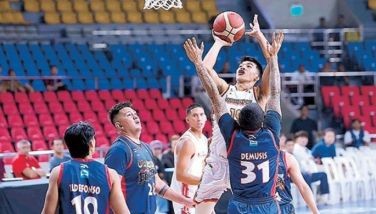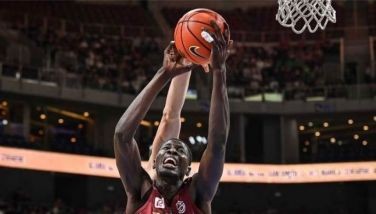Surrender or… ?

From March 5 to 8, 1906, about 790 US Army soldiers battled Muslim militants in a village built on the crater of Bud Dajo or Mt. Dajo in Jolo, Sulu.
The Muslims fought with swords, spears and grenades improvised from seashells and black powder. The weapons were no match for the Americans’ mountain guns, rifle grenades and even naval guns from ships in the nearby sea.
It was dubbed the “Moro Crater Massacre.†Of an estimated 800 to 1,000 villagers, including women and children, only six survived the US attack. The Americans lost from 18 to 21 men.
The slaughter did not end the problem or evict the Tausugs from Mt. Dajo. In December 1911, Bud Dajo was the site of a second battle between Muslim militants and US troops, this time under Gen. John J. “Black Jack†Pershing.
Between 1906 and 1911, as the US Army saw its .38 revolvers incapable of stopping Moro assailants, John Moses Browning designed a more powerful handgun. It was produced by Colt under the supervision of an ordnance board co-headed by Col. John T. Thompson, inventor of the Thompson submachine-gun. The result was the Colt Model 1911, unveiled on March 29, 1911, better known as the caliber .45 automatic pistol, which became the official sidearm of the US armed forces.
History books are replete with stories of those bizarre encounters between US troops and the Moro “juramentados†of Sulu.
Faced with the superior firepower of the Americans, the Moro fighters bandaged their torsos and limbs with layers of fabric and other materials. Cords were then wound tightly around strategic points in the bandaged areas, dividing the limbs in segments. If one segment took a bullet, the tight cord worked like a tourniquet, stanching blood flow and keeping the amok going in his deadly assault.
The caliber .45 automatic was created to deal with these killing machines wrapped in the primitive version of Kevlar. The greater firepower of the caliber .45 worked to some extent for the Americans. Like the Spanish colonizers, however, US forces never fully “pacified†the restive Muslim-dominated areas of Mindanao.
The juramentados and fighters of Bud Dajo were Tausugs. Fierce, proud, the Tausug would rather die than yield to the enemy. The Battle of Bud Dajo should give an idea of what Malaysian forces – and the Aquino administration – are up against in Sabah.
* * *
Threats, deadlines and calls for “surrender†won’t work, especially when what’s at stake is what the Tausugs consider their homeland. The best that can be done is to disperse the militants and keep them on the run. But even then it’s useful to bear in mind the saying that he who fights and runs away, lives to fight another day.
It’s reasonable for President Aquino to worry about the plight of an estimated 800,000 peace-loving Filipinos in Sabah. But first he and Malaysian Prime Minister Najib Razak must get the threat groups out of Sabah without risking protracted violent unrest.
P-Noy’s use of the word “surrender†is unfortunate. He could have urged the sultan’s followers to first “return home†to Mindanao where their proprietary claim could be discussed, even at the lowest levels of government if he simply wanted to toss them a bone as pacifier. He could still continue pursuing his conspiracy theory.
Instead he pushed them into a corner by telling them to surrender and warning that they faced arrest upon their return to the Philippines. Sometimes candor is a symptom of foot-in-mouth disease. The only option left for the sultan’s followers was to stand their ground and fight.
In Mindanao where nothing can part men from their guns, surrender is a dirty word.
Tausugs in particular have developed a reputation for not surrendering anything – not their weapons, not themselves. Clan and tribal leaders do not want to be seen by their followers as wimps in any act of surrender.
Peace negotiators of the government and the Moro Islamic Liberation Front wrestled with the idea of laying down rebel arms, which can be seen as a surrender of weapons. The prospect of laying down arms for an Islamic rebel group is so sensitive the MILF did not even want to describe it as “decommissioning†– the word used in the case of disarmament in the Northern Ireland peace process.
The government and MILF settled instead on “normalization.†And even with the mutually acceptable word, the process is fraught with potential pitfalls.
Getting the MILF to agree on normalization is considered a major achievement in the peace process. The Moro National Liberation Front did not agree to decommissioning or whatever you want to call it. MNLF chieftain Nur Misuari and his men held on to their weapons after they had signed the peace treaty with the government in 1996. Misuari even built up his arsenal when he became governor of the Autonomous Region in Muslim Mindanao.
Perhaps some of those weapons accumulated in that period are now being used in Sabah, where supporters of the Sulu sultanate are battling Malaysian forces. But MNLF officials insist that while some of their men are with the Sulu sultan’s army in Sabah, the MNLF is not participating in the armed clashes.
Those attacks by the sultan’s supporters in three districts of Sabah, however, look well executed, with Malaysian security officials killed or captured (Kuala Lumpur has not confirmed the capture).
As even Malaysian security officials have conceded, they appear to be facing battle-tested militants. Those armed men can’t possibly be ordinary civilian followers of the sultanate who went on an excursion to their ancestral land in Sabah. This tends to point a finger at the MNLF, which waged a secessionist rebellion for nearly three decades, much of it during a dictatorship, before signing the peace treaty.
Yesterday afternoon, Malaysia declared that the sultan’s army had been “totally routed… totally defeated.â€
But the fighters, shifting to guerrilla mode, sent word that they survived the air-and-ground assault and even intercepted a dub bomb from one of the Malaysian fighter jets.
When Princess Maryam of the Kiram clan says the sultan’s army in Sabah “will fight to the last man,†it is prudent not to dismiss it as bluster.
Surrender or die? In the land of the Tausugs, surrender is a fate worse than death.
- Latest
- Trending



























